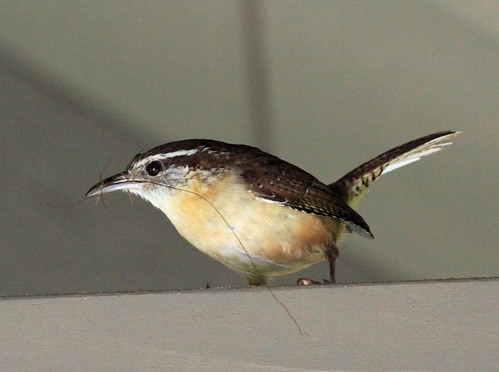Last week I got an email from one of my closest friends, Susan Eaton, who lives in St. Louis. She and I met when we were roommates on a birding tour to Ecuador back in 2006. Since then, I’ve spent time with her in Missouri a couple of times at birding events, and in her backyard a few times looking at Eurasian Tree Sparrows, and we went to Costa Rica together this past summer.
Susan has become a world birder of the highest order, having traveled all over the place. She writes:
Laura, I've been working in my garden the last three days, today while binge-listening to For The Birds Podcasts. I am enjoying the stories about others' favorite birds.
In the back corner of my yard where I was working a few days ago, I noticed a quiet high-pitched little whistle. I saw a Carolina Wren flirting about in some tall bushes. As I watched her, one by one, three little babies popped into view! They followed her from branch to branch. It must be a safe place for her babies because I have seen them in the same area for three days now.
Several years ago, a friend wanted to thank me for something. As we were leaving a rehearsal, she asked me what my favorite bird was. The first one that came to mind was Carolina Wren. She painted a beautiful picture of a Wren for me! She had never seen one before so she had to do some research. I think she did an amazing job!
My eBird list says I've recorded birds in 42 different countries (only part of those were dedicated bird trips), so I've seen many spectacular birds. But that feisty little Wren with the LOUD voice has to be a favorite. I know from my experience with my bird banding team that they are the species most likely to escape before we finish our processing, so they are loud, squirmy, beautiful little creatures with lovely markings. Carolina Wren....my best bird ever!
 |
| Carolina Wren painting by Carol Hassler |
These splendid birds sing their loud song a lot. One captive male Carolina Wren sang nearly 3,000 times in a single day. Birds pair off at any time of the year, and once bonded, the pair stays together for life, usually remaining on their territory year-round, and foraging and moving around the territory together.
Paired tropical wrens in the same genus as the Carolina Wren tend to sing duets, with the male and female both active singers. Unlike them, only male Carolina Wrens sing. Carolina Wrens are bigger than House Wrens, but their tea-kettle tea-kettle song has an extraordinary ringing quality and carries really far, belying the size of the bird.
Climate change seems to have expanded the Carolina Wren range northward. Once they become independent, Carolina Wren young scatter in any direction. Those that head north can thrive, even north of the species’ range, until a severe winter knocks them out.
Although wrens are almost exclusively insectivores, Carolina Wrens survive on suet, too. This kind of adaptability helps them make it through winters if they aren’t too severe. As Susan’s yard attests, they are superbly adapted to St. Louis County, Missouri. Although we have several records of individuals wandering into St. Louis County, Minnesota, it takes two to tango, so I suspect Carolina Wrens won’t be breeding up here regularly for quite some time. So I’ll just have to keep visiting Susan in her neck of the woods to see this excellent favorite bird.




